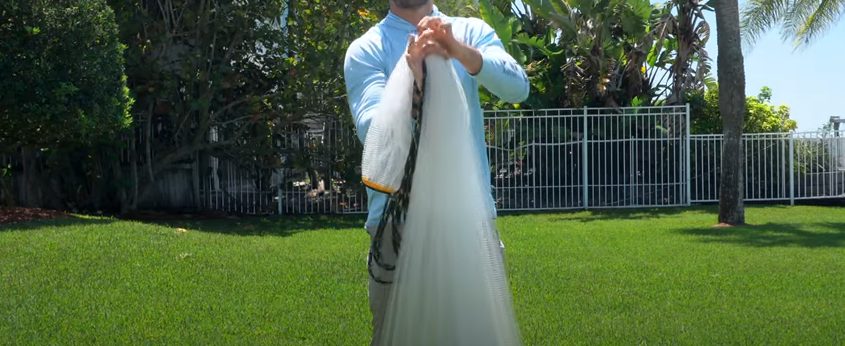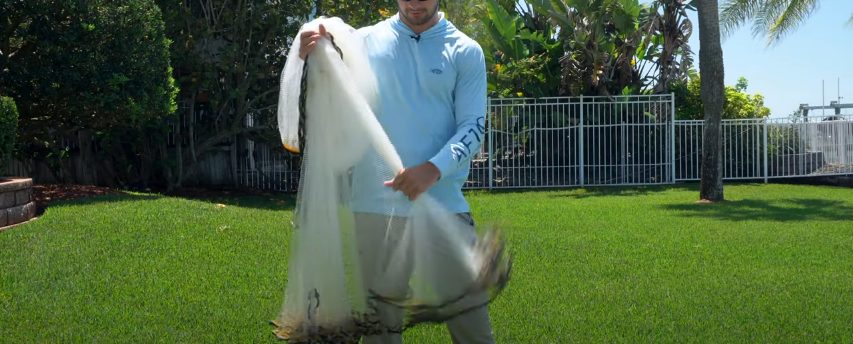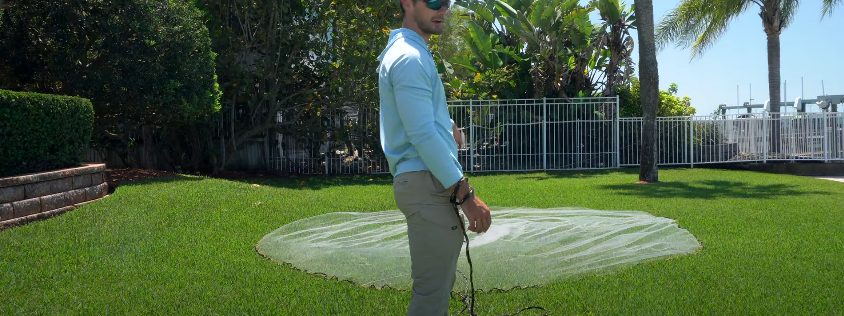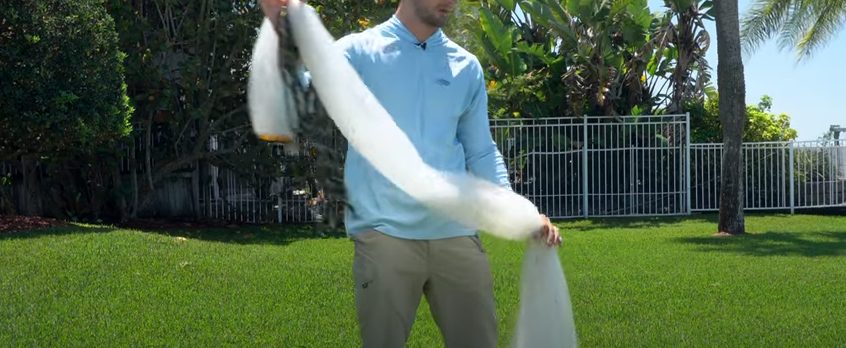In this article, I will show you the best easiest ways to deal with toss any size cast net. The chief way works for any size cast net from 3-12 feet in length. The resulting system is a speedy strategy to toss little cast nets that have a 6 foot or more unobtrusive range.
The most effective method to throw a cast net the simple way with basic simple to adhere to directions
This is the last educational exercise and set of tips you’ll need to sort out some way to toss a cast net. I’ve been an expert catfish guide for seemingly forever and contribute a huge load of energy tossing a cast net. This covers unequivocally what I do similarly as tips for progress tossing a cast net.
There are different ways to deal with toss a cast net and there is no right way. An authoritative target is that you can toss the net, get it to totally open up, and can get shad inside it. It really doesn’t have any effect on how you toss the net as long as these things happen. Also read the amazing product reviews about the Best Fishing Net Top 11 | Long Handle & Portable Fishing Nets Reviews by fishing verge.
Tossing a cast net is one of the most valuable ways to deal with getting trap for fishing. It is likewise a pleasant movement for youngsters to do to catch fish and afterward let them go. Intermittently individuals get disappointed when the cast net doesn’t open. With work on, throwing a cast net can be a great action. Cast nets range in size from 3-foot to 12-foot span and are made by various companies. In case you are hoping to track down the great cast check you the best cast net page.
How to Throw a Cast Net, Any Size, No Teeth, Stay Clean
Untangle the Cast Net

The main advance to throwing a cast net is to unravel the net. Some cast nets get more tangled than others. If the net gets found out in sticks and trash it will require some investment to unravel
A fast and simple approach to unwind the net is to pull 100% of the net starting with one side then onto the next. In case there are tangles the net won’t move between different sides and will get found out. Commonly pulling had or lifting one side will work out the knot.
The significance of unraveling the net is frequently ignored by individuals who throw cast nets. They expect the net doesn’t open as expected in light of the strategy. This could be the case yet more regularly the net is recently tangled and would not open as expected for any individual who tossed it. Now and again the net shouldn’t be unraveled and on different occasions it will require 2-10 minutes to appropriately unwind the net. In the event that the net is old, torn, or beat up it is significantly more prone to tangle.
Coil the Cast Net Hand-Line
The hand-line ought to be curled up actually like wrapping up and additional rope. Make little wraps and spot the rope in the right hand. In the event that the rope isn’t as expected got it can get found out in the cast net bringing about the net not opening as expected.
Straighten Out the Cast Net and Hold Under the Horn

Then, at that point, the net is moved into a straight line. The braille lines inside the net are related with the lead line and are what closes the net. These should be moreover being pulled absolutely straight. In the event that these are flabbergasted or bended the cast net most likely will not open or close suitably. Get the net close to the horn with the right hand.
Make Several Coils of the Net
Then, the net is maneuvered into a straight line. The braille lines inside the net are associated with the lead line and are what shuts the net. These ought to be likewise be pulled totally straight. In case these are amazed or curved the cast net probably won’t open or close appropriately. Get the net near the horn with the right hand.
Pull 1/3 of the Cast Net From the Front

Beginning from the left and pull out around 1/3 of the cast net. This is finished by fanning the net and gathering it to guarantee that there is no knot. Gathering the net this way is like how it was pulled starting with one side then onto the next to unravel the net in sync one.
Place the Collected Cast Net into the Right Hand
Then, take the gathered net and spot it in the right hand with the remainder of the wound net. Now, there are two segments of the net a high segment and a low area.
Take the Lead Line and Put it in the Right Hand

Snatch the lead line the beginning from the low segment of the cast net. Spot the line into the right hand. This assists with beginning opening the net immediately.
Collect 10 Percent of the Remaining Lead Line

Then, pull around 10% of the net from the lower segment of the net. This further isolates the net and makes it simpler to throw. In the event that the net is less than 6 feet, this progression won’t actually be required. For enormous cast nets, this makes it more reasonable to throw.
Swing the Net Back and Focus on the Bait

Swing the cast net back towards the back. This heaps the net and your muscles to go about like a spring to permit the net to be thrown forward with bunches of power. Watching the bait is vital just to guarantee a legitimate net situation. With huge cast nets, it will open straightforwardly before you so ensure that is the place where the bait is found. In the event that you throw to ahead of schedule or late, it doesn’t make any difference how great the opening is on the grounds that no bait is there to be gotten. Persistence and great planning regularly work better compared to a bunch of casting.
Throw the Net Forward with the Right Hand

From the start, it appears to be peculiar that simply throwing the net forward will make an enormous net open. How the cast net is wrapped permits the loads to fan out during the throw. On the off chance that the net has any knot, it can become caught and doesn’t separate as expected during the throw. Likewise, weighty side breezes can cause a halfway opening. Insubstantial breezes, it best to throw with the breeze. However, at times the baitfish don’t coordinate.
As the Net Spreads Out Pull Back with the Left Hand

In the wake of throwing the forward with the right hand pull back with the left hand. This happens rapidly and when you throw increasingly more it turns into a propensity. Clutch the net with the left hand a draw it across your body. As the net drops, it pulls on the left hand somewhat harder and that is a happy opportunity to deliver. This activity permits the loads to separate and open the net.
Make Short Tugs on the Hand-Line

When the net quits sinking the leeway in the line ought to be gathered. Make short little pulls while gradually pulling the net up at first. This permits the net to shut without really taking the net off the base. The cast net will likewise catch some other things on the base too like rocks, coral, sticks, and kelp.
In the wake of throwing the net in the space, you come out as comfortable with the base construction. A few bottoms like sand and soil permit the net to effectively shut on the base. In different spots, the net may get caught and even tear while pulling it up. While throwing in another spot I am wary from the beginning and may even throw a more modest net that is less inclined to stall out on the base. In case it is stuck you can generally hop in and unravel it. From shore, this is simpler than when on a boat.
Once the Net is Closed Pull Bait to the Surface
At the point when you see streaks in the net whenever it is sinking there is a decent possibility you got the bait. Periodically you can even feel vibrations in the hand-line from fish hitting into the net. In the image over the net is shut and you can see every one of the pilchards that are caught in the net? This is the thing that you need to see when you make a decent throw. In the event that there isn’t blazing, the odds are next to no bait was gotten.
Occasionally bait is hard to catch and surprisingly a couple of baits will be kept from an awful cast. On different days, assuming loads of baits are not gotten, the net will be purged out into the water to save time. Preferably, all the bait for the day can be trapped in one great throw. Normally, first thing in the morning the bait is generally dynamic close to the surface where it very well may be handily spotted and gotten.
Allow the Net to Drop Slightly Collecting the Bait in the Cast Net Pockets
At the point when a great deal of trap gets captured, it can really be hard to acquire and placed into live well. At the point when the lead line is practically out of the water, you need to do what is called dropping the net. This is finished by opening the grasp on the net so it slides through your hands briefly. It seems like an ill-conceived notion at first like the net may open and the snare will get away. Be that as it may, it simply permits a pocket to shape when the snare will gather. This makes the lure simpler to move into live well.
Empty the Bait into a live well
To purge then, at that point, net open the grasp on the net permitting the braille lines to slide down. This opens the lower part of the net so the bait will fall into the live well. Lift the net high and make a point to shake out any bait that may be stuck. At the point when the bait stockpiling area is raised, it tends to be hard to discharge the net straightforwardly into the tank. If so, having a huge pail or crate to exhaust the bait into is decent. The bait would then be able to be effectively moved to the live well.
Frequently Asked Questions
How does a cast network?
A cast networks by having a solitary individual throwing a 4-12 foot sweep net into the water. Lead loads around the border of the net permit the net to soak in the water. Braille lines are associated with a hand-line and when pulled it shuts the net. Bait can be trapped in water going from 1 foot deep to more than 20 feet down. Game fish cannot be kept in case they are trapped in a cast net. The aim of a cast net is to catch live baitfish.
How would you throw a cast net flawlessly?
They are various approaches to throw a small cast net. The triple burden strategy is a typical method to throw a huge cast net. In any case, with this strategy, the net should be set on the body. After the principal throw, the net is wet and it’s anything but an agreeable method to throw a net. The technique depicted above is the most straightforward approach to throw an enormous cast net. There is likewise the simple throw technique portrayed over that works extraordinary to throw little cast nets.
For an ideal cast net throw, the net ought to be stacked quickly. The technique ought not to need the net to be put on the individual and teeth ought not to be expected to hold the net. While throwing the net should open completely in a round circle. This is frequently called throwing a flapjack. The net ought to be in a situation to catch the most bait. At times this is straight over the fish and now and again the net ought to be set before where the fish are moving. At the point when the net sinks it should trap all the bait. The net should close without lifting so that bait doesn’t escape out the base. The bait ought to be immediately moved into a livewell.
What size cast net is ideal?
There are two sizes that are significant while choosing a cast net. First is the span of the cast net. Which size cast net is best relies upon the client’s capacities and the kind of fish being designated. A 3-foot span net is the littlest cast net. That size is made for youngsters. For grown-ups, a 4-foot range would be the littlest net you would probably need. A 12-foot net is acceptable for contract skippers that need to rapidly catch a bunch of bait for the whole day. A great many people are best off getting a net that has between a 5-10 feet sweep. Also check out the Best Fluorocarbon Leader Lines and Fishing Lines in 2022.
Next is the cross-section size which goes from 1/4 inch lattice to 1-1/4 inch square cross-section. Most lattice sizes given are as far as a square cross-section. For instance, a 3/8-inch square cross-section is 3/4 inches when extended. Another model is 1-1/4 square cross-section is 2-1/2 inch when extended. The most well-known cross-section size for cast nets is a 3/8 inch square lattice. This functions admirably for catching baits that are 2-6 creeps long. The best cast net page has a rundown of the many sorts and sizes of cast nets.


